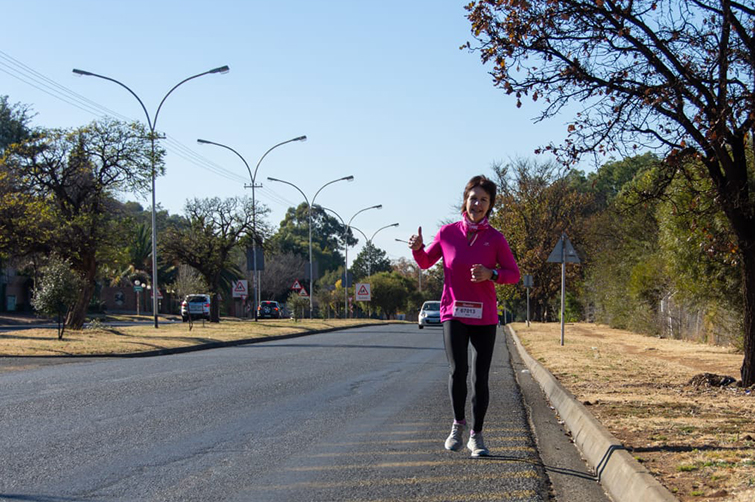Latest News Archive
Please select Category, Year, and then Month to display items
12 October 2020
|
Story Arina Engelbrecht
|
Photo Supplied
 Arina Engelbrecht from Organisational Development and Employee Well-being believes physical activity has a number of benefits for one’s health, including stress relief.
Arina Engelbrecht from Organisational Development and Employee Well-being believes physical activity has a number of benefits for one’s health, including stress relief.
Being physically active plays a big role in preventing the development of mental-health problems and in improving the quality of life of people experiencing mental-health problems.
Treatment for depression
Physical activity can be an alternative treatment for depression. It can be used as a stand-alone treatment or in combination with medication and/or psychological therapy. It promotes all kinds of changes in the brain, including neural growth, reduced inflammation, and new activity patterns are formed that promote feelings of calm and well-being. It releases endorphins – powerful chemicals in the brain that energise your spirit and make you feel good.
Physical activity can be very effective in relieving stress. Research in adults has found that physically active individuals tend to have lower stress levels compared to individuals who are less active. It also leads to improved sleep. When a person sleeps better and feels more rested, overall quality of life improves. They cope better with daily life stressors.
Reduce Alzheimer's risk
Regular physical activity can reduce your risk of developing Alzheimer's disease by up to 50%. It can also slow down further deterioration in those who have already started to develop cognitive problems. It stimulates the brain’s ability to maintain old connections as well as to make new ones.
A study asked people to rate their mood immediately after periods of physical activity (e.g. going for a walk/run, cycling, doing housework) and periods of inactivity (e.g. reading a book or watching television). Researchers found that participants felt more content, more awake, and calmer after being physically active compared to after periods of inactivity.
In conclusion, people who are physically active feel a sense of well-being, feel more energetic throughout the day, sleep better at night, have sharper memories, and feel more relaxed and positive about themselves and their lives.
“Being physically active not only changes your body, it changes your mind,
attitude, and your mood.” – Arina Engelbrecht
First book on Bloemfontein published in 25 years
2008-10-21
 |
|
During the launch of the book "Spatialities of Urban Change" are, from the left, front: Mr Malefetsane Mokoena, General Manager: Housing at the Mangaung Local Municipality and one of the co-authors of the book, Mr Amos Goliath, Executive Director: Corporate Affairs at the Mangaung Local Municipality, Ms Rothea van Biljon, Chairperson of the Afrikaanse Handelsinstituut Bloemfontein; back: Prof. Lochner Marais, editor of the book from the Centre for Development Support at the UFS, and Prof. Gustav Visser, editor of the book from the Department of Geography at the UFS. Photo Stephen Collett
|
|
|
The University of the Free State (UFS) has published a book on Bloemfontein for the first time in 25 years. The book, titled “Spatialities of Urban Change”, is the first South African scholarly account in book form of spatial themes on urban change in a secondary city in South Africa. The book was recently launched on the Main Campus in Bloemfontein.
The editors of the book are Prof. Lochner Marais from the Centre for Development Support and Prof. Gustav Visser from the Department of Geography, both from the UFS. Their co-authors are five Ph.D. students in Development Studies, one Ph.D. student in Geography and one master’s student in Development Studies.
According to Prof. Visser, there is a gap in the market for new perspectives on how cities work and how urban theory can develop. This book will contribute to filling that gap. The book also manages to involve students and their research – giving them the opportunity to have their research published.
The book addresses various aspects of Bloemfontein’s spatiality and issues such as suburbanization and the subsequent decline of the central business district, the city’s tourism potential and the impact of the Volksblad Arts Festival on re-imaging the city as a place that has something to offer any visitor, are discussed among others. Other topics include the suburb Westdene and how diverse spatiality manifests itself at this scale, and white flight from the inner city areas.
“A central theme running through the book is how the urban discourse of Bloemfontein relate to the country’s metropolitan core and conversely to other secondary cities,“ says Prof. Visser.
Media Release:
Issued by: Lacea Loader
Assistant Director: Media Liaison
Tel: 051 401 2584
Cell: 083 645 2454
E-mail: loaderl.stg@ufs.ac.za
22 October 2008
|